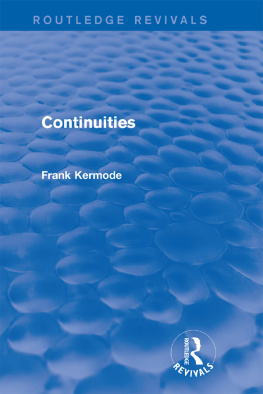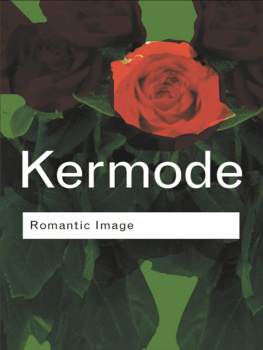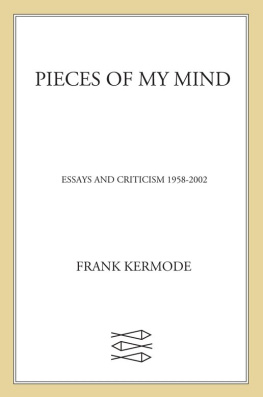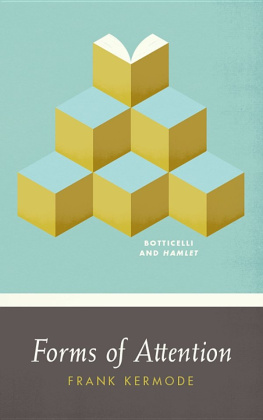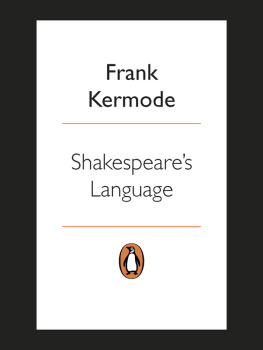Kermode - Continuities
Here you can read online Kermode - Continuities full text of the book (entire story) in english for free. Download pdf and epub, get meaning, cover and reviews about this ebook. year: 2015;1968, publisher: Taylor and Francis, genre: Art. Description of the work, (preface) as well as reviews are available. Best literature library LitArk.com created for fans of good reading and offers a wide selection of genres:
Romance novel
Science fiction
Adventure
Detective
Science
History
Home and family
Prose
Art
Politics
Computer
Non-fiction
Religion
Business
Children
Humor
Choose a favorite category and find really read worthwhile books. Enjoy immersion in the world of imagination, feel the emotions of the characters or learn something new for yourself, make an fascinating discovery.
Continuities: summary, description and annotation
We offer to read an annotation, description, summary or preface (depends on what the author of the book "Continuities" wrote himself). If you haven't found the necessary information about the book — write in the comments, we will try to find it.
Continuities — read online for free the complete book (whole text) full work
Below is the text of the book, divided by pages. System saving the place of the last page read, allows you to conveniently read the book "Continuities" online for free, without having to search again every time where you left off. Put a bookmark, and you can go to the page where you finished reading at any time.
Font size:
Interval:
Bookmark:
Routledge Revivals
Continuities
Continuities, first published in 1968, is a collection of reviews by Frank Kermode that appeared from 1962 to 1967. Kermode discusses a variety of novelists, poets, and critics, including T. S. Eliot, Northrop Frye, Wallace Stevens, Edmund Wilson, and Wallace Stevens. History and politics are two important aspects that are discussed in regards to these writers. This book is ideal for students of English literature.
Continuities
Frank Kermode

First published in 1968
by Routledge & Kegan Paul Ltd
This edition first published in 2015 by Routledge
2 Park Square, Milton Park, Abingdon, Oxon, OX14 4RN
and by Routledge
711 Third Avenue, New York, NY 10017
Routledge is an imprint of the Taylor & Francis Group, an informa business
1968 Frank Kermode
The right of Frank Kermode to be identified as author of this work has been asserted by him in accordance with sections 77 and 78 of the Copyright, Designs and Patents Act 1988.
All rights reserved. No part of this book may be reprinted or reproduced or utilised in any form or by any electronic, mechanical, or other means, now known or hereafter invented, including photocopying and recording, or in any information storage or retrieval system, without permission in writing from the publishers.
Publishers Note
The publisher has gone to great lengths to ensure the quality of this reprint but points out that some imperfections in the original copies may be apparent.
Disclaimer
The publisher has made every effort to trace copyright holders and welcomes correspondence from those they have been unable to contact.
A Library of Congress record exists under LC control number: 76352766
ISBN 13: 978-1-138-84070-6 (hbk)
ISBN 13: 978-1-315-73268-8 (ebk)
ISBN 13: 978-1-138-84072-0 (pbk)
CONTINUITIES

by
FRANK KERMODE

LONDON
ROUTLEDGE & KEGAN PAUL
First published 1968
by Routledge & Kegan Paul Limited
Broadway House, 6874 Carter Lane
London, E.C.4
Printed in Great Britain
by C. Tinling & Co. Ltd
Liverpool, London and Prescot
Frank Kermode 1968
No part of this book may be reproduced
in any form without permission from
the publisher, except for the quotation
of brief passages in criticism
SBN 7100 6176 5
CONTENTS

PREFACE

This selection of pieces written between 1962 and 1967 is in one sense a sequel to Puzzles and Epiphanies, which collected work from the three years before that. But although it occasionally takes up the same subjects it does seem to me a very different kind of collection. Whereas the earlier book was said to have a family resemblance to Romantic Image, a more speculative work of 1957, this one will undoubtedly be seen to take after another more solemn cousin, The Sense of an Ending (1967). It is called Continuities because it often returns to the cultural problem of schism and continuity, words which I picked up from V. W. Turners Schism and Continuity in an African Society. I lacked the nerve or folly to call the book Schisms and Continuities, and anyway am more in favour of continuities than of schisms.
Choosing what to include in a volume of this sort is not easy, and friends are usually astonished at what is put in and left out. For example, I wanted to include two pieces on Marshall McLuhan and also a long television conversation I did with him in January 1965 which was never broadcast because the B.B.C. thought it would be unintelligible. Now every schoolboy could understand it, which is why I decided not to have it in. And so with the other pieces, although I am not convinced that their objections to McLuhanism are quite obsolete. Sometimes one leaves in a rather old-fashioned piece out of affection, as here with the Dowson essay, and leaves out perhaps better things. The Dante essays ends the volume because it represents, for me, only, a sort of end, a sort of beginning.
Incidentally, this does not mean that I regard the kind of criticism here reprinted as anything but serious, though the level of seriousness varies a bit; and when I find it subjected to routine academic censure I find myself wondering whether the complainant is not one of those who might himself benefit from its peculiar discipline, and occasionally pass on the benefit to his pupils in graduate school, where it is not always easy to distinguish the solemn from the barbaric. Good literary journalism is valuable and rare. It would be too much to assert that it has only genius, wit and taste to recommend it, but to dismiss it as irremediably ephemeral, and at the same time to promote the preservation of the average doctoral dissertation, is to fall into what could very well be named the common cant.
Here I refer, of course, to this kind of work, not to the present book, which is for the reader to judge; I am only saying that the genre is more than respectable. The essay on Edmund Wilson tries to use the example of a great critic to state this more explicitly. Wilson can deal justly with other writers without neglecting the meditative movement of his own mind, and he can satisfy, without loss of intellectual integrity, the non-specialists urgent and entirely proper demand for amenity of exposition and fine texture. This is the kind of journalism I call valuable and rare. It is rare not because those who could easily do it have better things to do, but because it is more demanding than most of what passes for scholarship. It calls incessantly for mental activity, fresh information, and civility into the bargain. Of course I agree that they do not always come.
The pieces here collected appeared first in the New Statesman (Liii, II, in, VI, VII, X, XVII, XVIII, XIX, XXI, i and ii, XXII, i, XXIH, XXIV, XXV); the New York Review of Books (IV, XII, XIV, XVII, ii, XX); Encounter (Li, I.ii, part of IX, XI, i); Sewanee Review (VIII, X), Book Week (XI, ii) and Atlantic Monthly (XXII, ii). To the editors of these periodicals I offer my gratitude for their help, and for their permission to reprint. Parts of the long essay on Lawrence, and parts of the Afterthoughts on Wallace Stevens were included in a series of Alexander Lectures at the University of Toronto in 1967, and, attenuated as they are, must represent my gratitude to Clifford Leech and my other Toronto hosts.

Recently an advertisement for an ardent novel available only by mail described the work as the story of a modern American marriage. A favourable review was then cited, explaining that the painfully significant enigma of modern marriage is the ambition and aggressiveness of woman. The husband in Merediths sequence, lying there in tragic parody of a knight on a tomb, thought it was her infidelity. To both novelist and poet, modern seems to mean something not altogether agreeable and disturbingly at odds with the way things used to be. If pressed, they might talk about radical changes in sensibility, as they affect love. Pressed harder, they might have to admit that ambition, aggression, infidelity, are no newer in women than refined or perverse sensibility in men.
Next pageFont size:
Interval:
Bookmark:
Similar books «Continuities»
Look at similar books to Continuities. We have selected literature similar in name and meaning in the hope of providing readers with more options to find new, interesting, not yet read works.
Discussion, reviews of the book Continuities and just readers' own opinions. Leave your comments, write what you think about the work, its meaning or the main characters. Specify what exactly you liked and what you didn't like, and why you think so.

